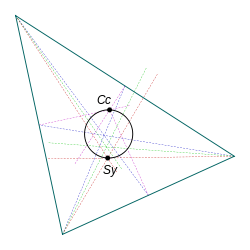Brocard circle

In geometry, the Brocard circle (or seven-point circle) for a triangle is a circle defined from a given triangle. It passes through the circumcenter and symmedian of the triangle, and is centered at the midpoint of the line segment joining them (so that this segment is a diameter).
The two Brocard points lie on this circle, as do the vertices of the Brocard triangle.[1] It is concentric with the first Lemoine circle.[2]
If the triangle is equilateral, the circumcenter and symmedian coincide and therefore the Brocard circle reduces to a single point.[3]
The Brocard circle is named for Henri Brocard,[4] who presented a paper on it to the French Association for the Advancement of Science in Algiers in 1881.[5]
References
- ↑ Cajori, Florian (1917), A history of elementary mathematics: with hints on methods of teaching, The Macmillan company, p. 261 .
- ↑ Honsberger, Ross (1995), Episodes in Nineteenth and Twentieth Century Euclidean Geometry, New Mathematical Library, 37, Cambridge University Press, p. 110, ISBN 9780883856390 .
- ↑ Smart, James R. (1997), Modern Geometries (5th ed.), Brooks/Cole, p. 184, ISBN 0-534-35188-3
- ↑ Guggenbuhl, Laura (1953), "Henri Brocard and the geometry of the triangle", The Mathematical Gazette, 37 (322): 241–243, JSTOR 3610034 .
- ↑ O'Connor, John J.; Robertson, Edmund F., "Henri Brocard", MacTutor History of Mathematics archive, University of St Andrews .
External links
See also
This article is issued from
Wikipedia.
The text is licensed under Creative Commons - Attribution - Sharealike.
Additional terms may apply for the media files.